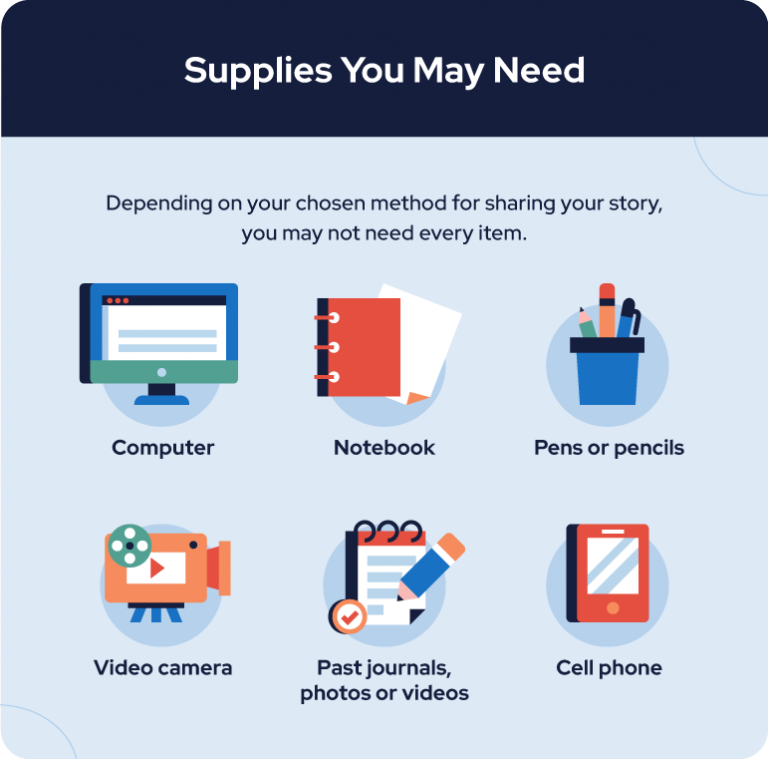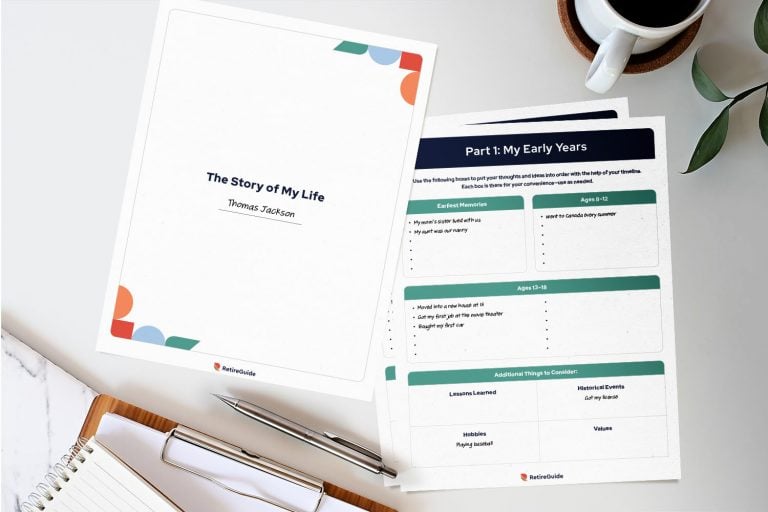How To Tell Your Life Story in 6 Simple Steps
Sharing your story with others can deepen relationships and potentially improve different aspects of your descendants' lives. Use the steps and tips below to learn how to tell your life story — and additional benefits for doing so.

- Written by Christian Simmons
Christian Simmons
Financial Writer
Christian Simmons is a writer for RetireGuide and a member of the Association for Financial Counseling & Planning Education (AFCPE®). He covers Medicare and important retirement topics. Christian is a former winner of a Florida Society of News Editors journalism contest and has written professionally since 2016.
Read More- Edited By
Lee Williams
Lee Williams
Senior Financial Editor
Lee Williams is a professional writer, editor and content strategist with 10 years of professional experience working for global and nationally recognized brands. He has contributed to Forbes, The Huffington Post, SUCCESS Magazine, AskMen.com, Electric Literature and The Wall Street Journal. His career also includes ghostwriting for Fortune 500 CEOs and published authors.
Read More- Published: January 12, 2022
- Updated: June 23, 2023
- 8 min read time
- This page features 1 Cited Research Article
- Edited By
Your story is the legacy you leave behind, and in many cases, it can provide answers to questions your descendants may have about their health and family history. Understanding this history is the key to improving health, finances and other life circumstances for generations to come.
The process can be tedious, so knowing how to tell your life story is vital to making sure you finish the task. Whether you’ve been retired for years or are still raising a family, the steps below will help you start and finish your memoir or autobiography.
1. Gather Supplies and Get Organized
Before you tell your life story, gather your supplies. Having supplies ready can help eliminate distractions and keep you focused.
This is also a good time to think about what method you’ll use to tell your story. You may decide to use a few different methods. For example, you may want to record audio of your story, but it would be helpful to prepare by writing specific moments down.

2. Brainstorm Key Events
Life is constantly changing. These changes can create life experiences which can be the key to telling an engaging and inspiring life story.
If nothing ever changed, you wouldn’t have much to tell.
There are likely many impactful moments and memories you could include in your story. The second step helps you determine what things you should include to tell the most impactful story.
Start by deciding if you want to share your memoir or your autobiography. A memoir is typically filled with personal anecdotes and lessons, while an autobiography is more often a sequence of events from childhood to where you are now.
You can also choose to do a little of both. By showing the experiences you had in your childhood years, you may be better able to explain the value of your successes in young or middle adulthood.
Whatever you decide, brainstorm as many impactful moments and experiences you can think of. These can include:
- Graduations
- Health matters (surgeries, strokes, etc.)
- Career advancements
-
Family events
- Babies born
- Children adopted
- Children’s accomplishments
- Parents passing away
To generate more ideas, look through past photographs, videos or journal entries. You may also find it helpful to talk with friends and family about their favorite memories with you, especially if your health is declining or you’ve experienced memory loss.
Use the brainstorm template below to make note of the moments you’d like to include in your story.

3. Create an Outline
The next step to telling your life story is organizing the experiences that shaped you into chronological order. While this isn’t required, it’s one way to organize your thoughts and make sure you’re including the most valuable information.
By using a computer, notebook or the template below, organize the experiences and events you brainstormed above. After including those in your timeline, consider thinking through additional events you’d like to include in your story. These may include:
- Childhood and teenage experiences
- Early memories
- Lessons learned from your loved ones
- Stories from your parents
- Hardships and struggles
- Trends
- Accomplishments
- Friends who left an impact on you
If you’re unsure how to start your outline, the template below can help you make a timeline of your life so you can organize the events and moments you want to include in your story.

4. Explain Your Values, Personal Qualities and Traits
Certain character traits, values and interests that make you who you are likely won’t fit neatly in a timeline or outline. However, they are still valuable pieces of who you are, and shouldn’t be excluded from your story.
To brainstorm more about who you are, use the empty boxes in the brainstorm template or write them down in your notebook. You can include points such as:
- Values
- Religious beliefs
- Political affiliation and beliefs
- Turning points that shaped your beliefs
- Interests
- Sports
- Hobbies
- Character traits
- Pet peeves
From here, decide where these fit best in your story. You may want to start with your character traits and family history and then lead into your childhood. Or you could include specific hobbies character traits or values at certain phases of your life when they seemed to make the most impact on your decisions and life direction.
5. Write or Record With No Edits
When writing or recording your first draft, allow yourself to get everything out before going back to edit. If you’re focused on making your first draft perfect, you’ll be distracted and likely not able to communicate the information that you’d like to include.
Accepting that your first draft will have errors and rough patches can help you overcome the perfectionism many feel when doing something as significant as recording history.
The first draft is just you telling yourself the story.
6. Revise
The revision period is the time to go back through everything you’ve put together. You can improve your word choice, sequence of events and even remove information you no longer feel is necessary.
Fact-checking is also important during this step. Reviewing past journal entries, talking with others and even looking through past news articles can help you make sure the facts you include are accurate.
Life Story Template
Not everyone is a natural wordsmith or storyteller. For some, connecting the dots between ideas and memories is difficult. To overcome this, consider creating a full outline of events, memories or other points you want to include in your story.
Use the life story template below to combine everything together and ensure there are smooth transitions from one memory or anecdote to the next.

Creative Ways to Share Your Life Story
Telling your story doesn’t have to be boring. There are numerous ways to share it creatively and enjoy doing so.
| Physical Autobiography | It’s now easier than ever to self-publish books, particularly about your life story, on sites like Storyworth and A Life Untold. |
| Audio Recordings | Record yourself telling your story and keep the USB in a keepsake box or safe. |
| Social Media | Record important events and memories on your social media account. If you choose this method, be aware of privacy settings available to you and ownership rights on different platforms. |
| Blog | You can start your own blog for free or with little cost. If you choose this method, have a plan for what to do with your articles, posts and pictures when you can no longer keep up with the blog. |
| Write a Novel | Using your own experiences in life, write a novel to share with others. You can change character names and add in a few extra details while sharing truthful, impactful moments of your life. |
Knowing which method to choose can be a difficult decision. However, you don’t have to stick to just one method. Try a few different ways to share your life story and read or listen to samples of other personal life stories to get an idea of what you like best.
The Importance of Sharing Your Medical History
Your life story is one of the best ways to keep your memory alive once you’re gone. But it’s also one of the most tried-and-true methods for warning your family members of potential health conditions they may be at risk of getting. By including specific health or healthcare mistakes, you’ll also be warning your loved ones of what to avoid.
A Guide to Genetics and Health, a book written by Genetic Alliance, outlines specific diseases that often run through family lines. These conditions include heart disease, asthma, cancer and more. Some of these conditions can be prevented by getting regular doctor checkups and maintaining a healthy lifestyle, among other things.
While the goal should always be to live a healthy lifestyle, understanding conditions that run in your family is an added incentive to take care of yourself. After all, if you’re unaware of any health concerns, how can you actively work to prevent them?
General Tips for Your Story
It’s true that you should be honest with yourself when writing your story. However, there are a few other things you should keep in mind when compiling your memories and anecdotes.
- Avoid blame: Don’t criticize others. (But if you must, consider altering the circumstances to protect the person’s identity. Add a disclaimer at the beginning if you choose to do this.)
- Share the hard moments: Include what you learned from the tough times you share.
- Avoid condescending language: The goal is for others to read it, after all.
- Choose a theme: If you’re having trouble knowing what to include, choose a theme — such as a specific hardship or career accomplishments — and stick to it throughout.
If you’ve never written or told a story before, you may have to undergo several rounds of editing to achieve what you’re looking for. Consider having a nonjudgmental friend, relative or neutral third party help in the revision process for an extra set of eyes.
Now that you know how to tell your life story, it’s time to go out and share it. Make it clear that it’s not just for your benefit, but for your family’s as well.
After reminiscing about all your life events and personal health choices, you may think a more comprehensive health insurance plan will be a better fit for your life circumstances.
If this is the case, talk with a Medicare advisor about the type of plan that will best support your future health goals and needs.
Connect With a Financial Advisor Instantly
Our free tool can help you find an advisor who serves your needs. Get matched with a financial advisor who fits your unique criteria. Once you’ve been matched, consult for free with no obligation.
1 Cited Research Article
- Genetic Alliance. (2006). A Guide to Genetics and Health. Retrieved from https://www.ncbi.nlm.nih.gov/books/NBK115605/
Calling this number connects you to one of our trusted partners.
If you're interested in help navigating your options, a representative will provide you with a free, no-obligation consultation.
Our partners are committed to excellent customer service. They can match you with a qualified professional for your unique objectives.
We/Our Partners do not offer every plan available in your area. Any information provided is limited to those plans offered in your area. Please contact Medicare.gov or 1-800-MEDICARE to get information on all of your options.
844-359-1705Your web browser is no longer supported by Microsoft. Update your browser for more security, speed and compatibility.
If you need help pricing and building your medicare plan, call us at 844-572-0696




